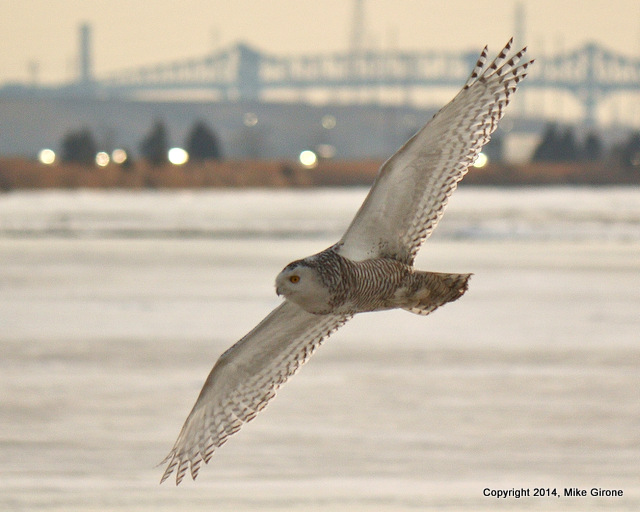 Jim Wright, who maintains this blog, also writes a monthly column for the South Bergenite. His latest column is an interview with NJMC naturalist about birds we might see in the coming weeks:
Jim Wright, who maintains this blog, also writes a monthly column for the South Bergenite. His latest column is an interview with NJMC naturalist about birds we might see in the coming weeks:
Early December in the Meadowlands is a time to look ahead and predict what rare birds might be coming our way this season.
Winter, after all, can be a prime time for seeing rarities — especially a certain charismatic white owl.
“Right now, snowy owls are being seen in the vicinity of the Meadowlands,” says N.J. Meadowlands Commission naturalist Mike Newhouse. “It might be just a matter of time until one is found here.”
Early 2014 saw an invasion of these large raptors the likes of which had not been seen in decades. During one stretch, a snowy owl was seen daily in DeKorte Park.
Sometimes the owl would be seen sitting on the ice in an impoundment. After the ice thawed, it could be seen sitting on a park bench, watching the ducks that swam past it.
The most amazing sighting came one Saturday afternoon last February, when lucky DeKorte visitors got to see four snowy owls at once!
Newhouse says two other raptors from the north — rough-legged hawks and short-eared owls — could be seen again in coming weeks.
As for smaller visitors, Newhouse reports that American pipits and horned larks are already being spotted in Lyndhurst along Valley Brook Avenue and Disposal Road.
“Hopefully, it will be a good year for Snow Buntings and Lapland Longspurs as well,” he adds.
Birds from Canada head south in the winter for a variety of reasons, including extreme temperatures and food availability, but why are they drawn to the Meadowlands in particular?
“The habitat,” says Newhouse, who has run the commission’s bird-banding research program for the past seven years. “Open meadows on landfills can provide food for a lot of different species. Rodents reside in meadows, and scrub habitat during winter which can attract a variety of raptors.”
Snowy Owls are drawn to the Meadowlands because of the open habitat that resembles their northern territories, Newhouse explains, and the abundance of rabbits and waterfowl gives them ample opportunity for hunting.
“Smaller birds like Horned Lark, Snow Bunting, and Lapland Longspur like the open habitats of the landfills and like to eat seeds from the abundance of plants found in this area,” he says.
Perhaps the rarest bird to watch for is the northern shrike. The last one that wintered here arrived five years ago around Dec. 10, and it stayed until Saint Patrick’s Day.
The small hook-billed predator loved to hang out along Disposal Road, remaining hidden for much of the time — to the consternation of birders who had come from all over the East Coast in hopes of seeing it.
What are the chances of a shrike coming our way again this month?
“We can only hope,” says Newhouse, “and keep scanning the tops of trees and wires where they like to perch.”

excellent ….all